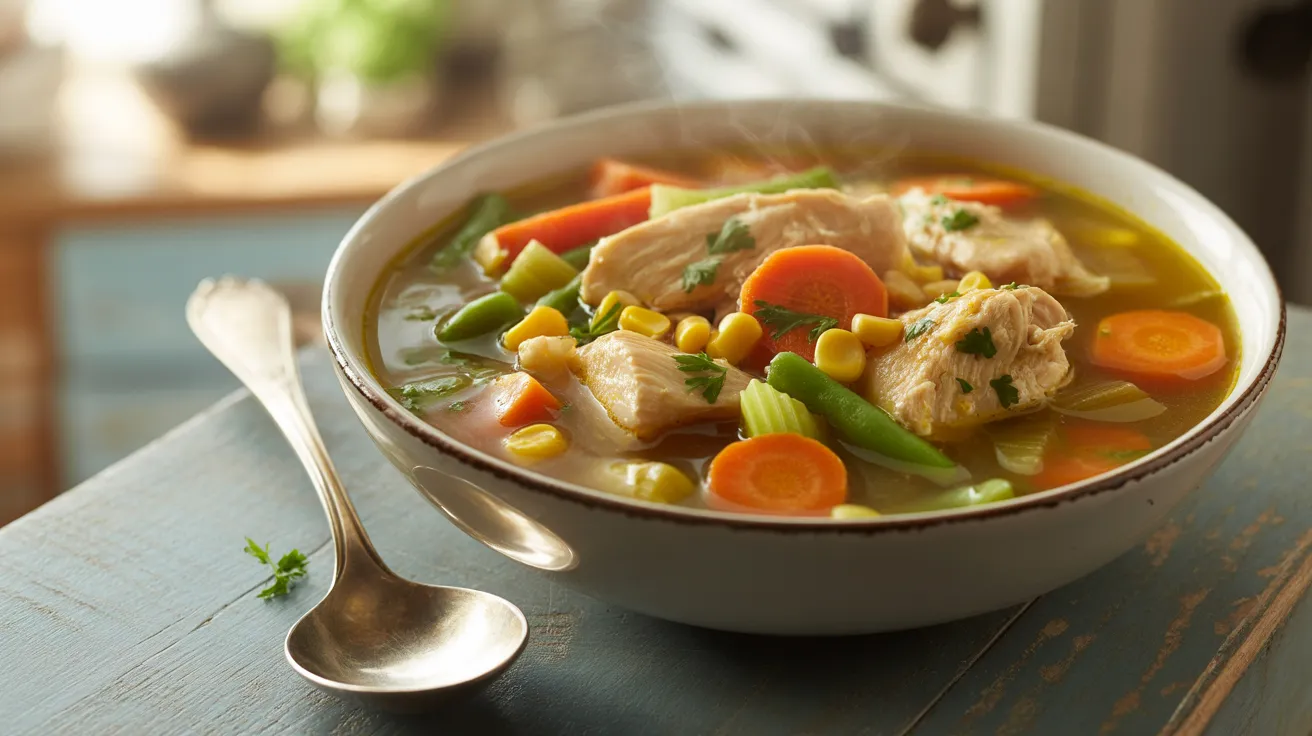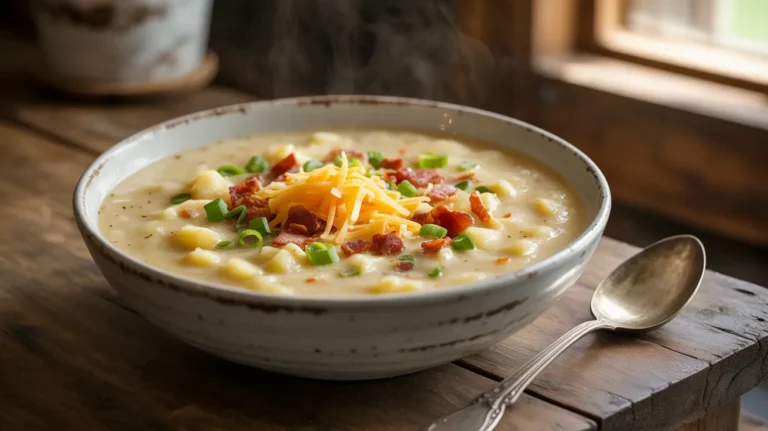This comforting chicken vegetable soup brings together tender chicken, fresh vegetables, and aromatic herbs in a soul-warming bowl that’s perfect for any day of the year. Our chicken vegetable soup recipe creates a restaurant-quality dish right in your own kitchen, delivering rich flavors and satisfying nutrition that the whole family will love. This beginner-friendly chicken vegetable soup guide walks you through every step to ensure perfect results every time.
SERVES: 4 | PREP: 20 MIN | COOK: 25 MIN | TOTAL: 45 MIN
Ingredients for Perfect Chicken Vegetable Soup
Protein Base
| Ingredient | Amount |
|---|---|
| Boneless, skinless chicken breasts | 1 lb (2 large breasts) |
| Olive oil | 2 tablespoons |
Vegetable Mix
| Ingredient | Amount |
|---|---|
| Yellow onion, diced | 1 medium |
| Carrots, sliced | 2 large |
| Celery stalks, chopped | 2 stalks |
| Garlic cloves, minced | 3 cloves |
| Fresh green beans, trimmed | 1 cup |
| Corn kernels (fresh or frozen) | 1 cup |
Liquid & Seasonings
| Ingredient | Amount |
|---|---|
| Low-sodium chicken broth | 6 cups |
| Bay leaves | 2 leaves |
| Fresh thyme | 1 tablespoon |
| Salt | 1 teaspoon |
| Black pepper | ½ teaspoon |
| Fresh parsley, chopped | ¼ cup |
Detailed Step-by-Step Chicken Vegetable Soup Instructions
Phase 1: Essential Prep Work (8 minutes)
Step 1: Prepare Your Workspace Clear a large cutting board and gather all ingredients. Having everything ready (called “mise en place” by chefs) makes cooking this chicken vegetable soup much smoother. Safety tip: Always wash your hands after handling raw chicken.
Step 2: Season the Chicken Properly Pat the chicken breasts completely dry with paper towels – moisture prevents proper browning. Sprinkle ½ teaspoon salt and ¼ teaspoon pepper evenly on both sides. Press the seasoning gently into the meat with your fingertips. Why this matters: Early seasoning allows flavors to penetrate the chicken rather than just sitting on the surface.
Step 3: Master Your Vegetable Prep Onion: Cut off both ends, peel away papery skin, then dice into ½-inch pieces. Keep pieces uniform for even cooking. Carrots: Peel and slice diagonally into ¼-inch thick rounds. Diagonal cuts cook faster and look more professional. Celery: Wash thoroughly, trim ends, and chop into ½-inch pieces. Include some leaves for extra flavor. Garlic: Peel cloves, then mince finely with a sharp knife. Pro tip: Crush cloves with the flat side of your knife first to make peeling easier.
Step 4: Prepare Remaining Vegetables Green beans: Snap off stem ends and cut into 1-inch lengths. Fresh beans add excellent texture to chicken vegetable soup. Corn: If using fresh, cut kernels from cob. Frozen corn works perfectly and saves time.
Phase 2: Building the Flavor Base (10 minutes)
Step 5: Heat Your Cooking Oil Correctly Place your large soup pot or Dutch oven over medium-high heat. Add 2 tablespoons olive oil and swirl to coat the bottom. Temperature check: The oil should shimmer and move freely but not smoke. If it smokes, reduce heat immediately.
Step 6: Sear Chicken for Maximum Flavor Gently lay chicken breasts in the hot oil – they should sizzle immediately. Don’t move them for 4-5 minutes to develop a golden-brown crust. Common mistake: Moving chicken too early prevents proper browning. Flip carefully and sear the other side for 4-5 minutes. The internal temperature should reach 165°F, but don’t worry if it’s not quite there – it will finish cooking in the soup.
Step 7: Rest and Dice the Chicken Remove chicken to a clean plate and let it rest for 3-4 minutes. Important: Don’t wash the pot – those brown bits (called fond) will add incredible flavor to your chicken vegetable soup. While chicken rests, it will be easier to dice. Cut into ¾-inch cubes for perfect bite-sized pieces.
Step 8: Start Your Vegetable Foundation Return the pot to medium heat (slightly lower than before). Add diced onions to the same pot with the fond. Listen for gentle sizzling – this means your temperature is perfect. Cook for 3-4 minutes, stirring occasionally with a wooden spoon. Visual cue: Onions should become translucent and slightly golden, not brown.
Phase 3: Layer Your Vegetables (8 minutes)
Step 9: Add Your Harder Vegetables First Add chopped carrots and celery to the pot with onions. These vegetables need more cooking time, so they go in first. Stir gently and cook for 4-5 minutes. Texture check: Vegetables should begin to soften but still have some firmness. Why this timing matters: Adding all vegetables at once results in mushy carrots or crunchy celery.
Step 10: Incorporate Garlic Perfectly Push vegetables to one side of the pot and add minced garlic to the cleared space. Cook for 30-45 seconds until fragrant. Critical timing: Garlic burns quickly and becomes bitter, so watch carefully. Stir garlic into the other vegetables once it smells amazing.
Phase 4: Assembling Your Chicken Vegetable Soup (15 minutes)
Step 11: Add Broth and Seasonings Pour in 6 cups chicken broth slowly to avoid splashing. The liquid should cover vegetables by about 1 inch. Add 2 bay leaves and 1 tablespoon fresh thyme. Heat adjustment: Increase to medium-high heat and bring to a gentle boil. Visual cue: You’ll see small bubbles breaking the surface consistently, not a rolling boil.
Step 12: Return Chicken to the Pot Once the broth is simmering, add your diced chicken pieces. The chicken will finish cooking in the hot broth, staying tender and moist. Temperature tip: Maintain a gentle simmer – aggressive boiling will make chicken tough.
Step 13: Add Green Beans at the Right Time After the soup has simmered for 5 minutes with the chicken, add green beans. Fresh green beans need about 8-10 minutes to become tender-crisp. Doneness test: Pierce a green bean with a fork – it should go through easily but still have slight resistance.
Step 14: Perfect Corn Timing In the final 3 minutes of cooking, add corn kernels. Corn cooks very quickly and becomes mushy if overcooked. Frozen corn tip: No need to thaw first – add directly to the hot soup.
Phase 5: Final Touches for Perfect Chicken Vegetable Soup (3 minutes)
Step 15: Season and Adjust Remove bay leaves immediately – they’ve done their job and can be bitter if left in. Taste your chicken vegetable soup carefully. Seasoning guide: You’ll likely need ½-1 teaspoon additional salt and ¼ teaspoon more pepper. Add gradually and taste after each addition.
Step 16: Fresh Herb Finish Remove pot from heat and stir in fresh chopped parsley. Timing is crucial: Adding herbs off the heat preserves their bright color and fresh flavor. Alternative herbs: Fresh dill or chives work beautifully too.
Step 17: Final Quality Check Chicken doneness: Cut into a piece of chicken – it should be completely white with no pink areas and reach 165°F internal temperature. Vegetable texture: All vegetables should be fork-tender but not mushy. Broth consistency: Should be flavorful and aromatic, not thin or bland.
Chef’s Notes for Perfect Chicken Vegetable Soup
Chicken Selection: Boneless, skinless chicken breasts create the cleanest flavor profile for chicken vegetable soup, but thighs add richness if you prefer. Temperature control is more important than the cut you choose.
Vegetable Timing Strategy: The secret to great chicken vegetable soup lies in adding vegetables based on cooking time. Root vegetables need 8-10 minutes, while delicate vegetables like corn need only 2-3 minutes.
Broth Quality Impact: Low-sodium chicken broth gives you complete control over salt levels in your chicken vegetable soup. Upgrade tip: Add 1 tablespoon chicken base for restaurant-quality depth.
Texture Balance Secrets: Keep all vegetable pieces uniform in size for even cooking and professional presentation. This attention to detail separates good chicken vegetable soup from exceptional versions.
Nutrition Information (Per Serving)
- Calories: 285
- Protein: 28g
- Carbohydrates: 18g
- Fat: 12g
- Fiber: 4g
- Sodium: 680mg
Creative Chicken Vegetable Soup Variations
Mediterranean Style: Transform your basic chicken vegetable soup by adding diced tomatoes, white beans, and oregano for a Greek-inspired twist. This variation pairs perfectly with our Tuscan chicken soup for an Italian-themed dinner.
Asian Fusion Chicken Vegetable Soup: Include fresh ginger, bok choy, and a drizzle of sesame oil for an Eastern flair that completely transforms your standard recipe.
Creamy Comfort Version: Stir ½ cup heavy cream into your chicken vegetable soup during the last 2 minutes for a luxurious, restaurant-style finish that kids especially love.
Hearty Harvest Style: Add diced sweet potatoes and butternut squash for fall flavors, or try our Greek lemon chicken soup for bright Mediterranean variety.
Storage & Reheating Your Chicken Vegetable Soup
Refrigerator Storage: Keep leftover chicken vegetable soup covered for up to 4 days. The flavors actually improve overnight as ingredients meld together.
Freezer Storage: Freeze portions in individual containers for up to 3 months. Leave 1-inch headspace for expansion during freezing.
Reheating Guidelines: Warm chicken vegetable soup gently over medium-low heat, stirring occasionally. Add a splash of broth if the soup has thickened too much during storage.
Make-Ahead Strategy: Prepare all vegetables the night before and store covered in the refrigerator to streamline your chicken vegetable soup preparation time.

Troubleshooting Your Chicken Vegetable Soup
Problem: Overcooked, mushy vegetables Solution: Add harder vegetables like carrots first, softer ones like corn later. Cook until just tender-crisp for the best texture in chicken vegetable soup.
Problem: Bland, flavorless soup Solution: Season in layers throughout cooking – salt the chicken, season during cooking, and adjust at the end. Don’t forget a splash of lemon juice for brightness.
Problem: Dry, tough chicken pieces Solution: Don’t overcook the chicken during initial searing. It finishes cooking gently in the simmering broth of your chicken vegetable soup.
Problem: Thin, watery broth Solution: Simmer uncovered longer to concentrate flavors, or mix 1 tablespoon cornstarch with cold water and stir into your chicken vegetable soup.
Problem: Greasy surface on soup Solution: Skim fat with a ladle while hot, or chill overnight and remove the solidified fat layer before reheating your chicken vegetable soup.
Essential Equipment for Chicken Vegetable Soup
- Large soup pot or Dutch oven (6-quart minimum capacity)
- Sharp chef’s knife for efficient vegetable prep
- Large cutting board with non-slip base
- Wooden spoon for gentle stirring without scratching
- Ladle for neat serving
- Measuring cups and spoons for accuracy
- Instant-read thermometer for chicken safety
Complete Shopping List for Chicken Vegetable Soup
Meat Counter
- 1 lb boneless, skinless chicken breasts
Produce Section
- 1 medium yellow onion
- 2 large carrots
- 2 celery stalks with leaves
- 1 head fresh garlic
- 1 cup fresh green beans
- Fresh thyme bunch
- Fresh parsley bunch
Pantry & Frozen Items
- Extra virgin olive oil
- Low-sodium chicken broth (48 oz container)
- Dried bay leaves
- Kosher salt and fresh black pepper
- 1 cup frozen corn kernels
Five Success Secrets for Amazing Chicken Vegetable Soup
1. Master the Chicken Searing – Proper browning creates the flavor foundation for exceptional chicken vegetable soup. Don’t skip this crucial step.
2. Cut Vegetables Uniformly – Consistent sizing ensures even cooking and creates the professional presentation that makes great chicken vegetable soup.
3. Layer Your Seasonings – Season at multiple stages rather than just at the end for deeper, more complex flavor development in your chicken vegetable soup.
4. Control Your Heat – Gentle simmering keeps chicken tender and vegetables perfectly textured. Aggressive boiling ruins the final result.
5. Taste and Adjust Constantly – Your palate is the best guide for creating the perfect chicken vegetable soup that matches your family’s preferences.
This comprehensive chicken vegetable soup recipe delivers comfort in every spoonful while remaining simple enough for complete beginners. The combination of perfectly seasoned chicken, fresh vegetables, and aromatic herbs creates a satisfying meal that brings families together around the dinner table, making it the perfect addition to your weekly meal rotation.




